Three main surgical options are presented here: amputation, limb salvage surgery, and rotationplasty. The pros, cons, and issues of each option are discussed, and printable tables are provided. Links to social support are at the end, so you can talk to people who have made a similar decision. For more information, including links to explore prosthetics, go to the Resources section in Life After Surgery.
Three Main Surgical Options
Your chances of doing well in terms of survival are about the same regardless of which surgical option you choose unless your surgeon tells you otherwise. Some people will have a better chance of survival with a specific surgery, depending on the location or stage of the tumor.
Infection is a risk for all three options, particularly if chemotherapy and/or radiation is part of the treatment plan. An infection might mean a longer recovery or additional surgery. For limb salvage, an infection may require a new implant or changing to amputation or rotationplasty. For rotationplasty, an infection may mean changing to amputation.
Our surgeon provided a presentation of the options for surgery including pro/cons for each option. We (parents) then presented the options to our 12-year-old. We wanted his honest opinion without any influence. When he chose which surgery he wanted, we went into more details about the potential setbacks for that surgery and the benefits.
As you read and hear patient stories, you will find people who are very happy and very unhappy with all the options. In general, people are happy if they understand the pros and cons of each option ahead of time. Actively participating in making the decision and accepting that there is no one right decision will help you feel more comfortable with the decision you make.
People tend to steer away from rotationplasty and amputation because you lose a part of the body. But on the positive side, you don’t have to avoid high-impact activities and you don’t have to keep returning to the hospital for surgery as the limb salvage wears out.
The three main options for surgery are discussed in alphabetical order throughout this decision aid: amputation, limb salvage surgery, and rotationplasty.
Amputation
An amputation for a tumor around the knee joint means the removal of the leg above the knee, referred to as an above knee amputation or AKA. The leg is referred to as the limb or the “residual limb.”
Your surgeon can shape the limb so that an artificial leg or prosthesis will be more comfortable. They can also bundle the nerves at the end of your limb to lessen the chances of feeling pain where the leg used to be, or phantom limb pain. Ask your surgeon about targeted muscle reinnervation (TMR) for guarding against phantom limb pain later.
A prosthetist is a specialist who creates a socket and artificial leg (prosthesis) just for you. Sometimes people choose not to use a prosthesis and use other methods for getting around, like crutches or a wheelchair. Usually, people choose a combination of assistive devices such as forearm crutches to use when they are not wearing their prosthesis.
People with amputations can be very active if they have a good fit with their prosthesis.
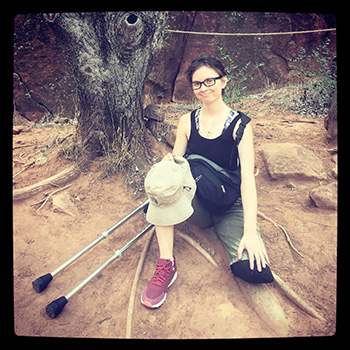
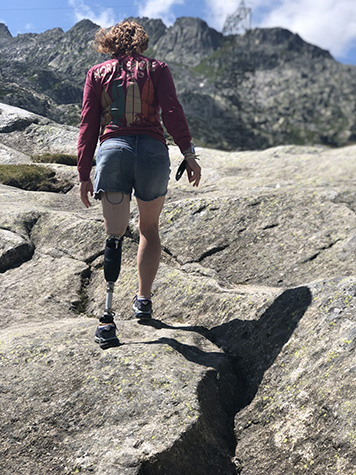
Some people will think about amputation as a failure or not the optimal goal. I would argue that in reality the long-term results of amputation are excellent. As prosthetics get better and better with robotics, computers, and batteries, amputation might be the best competitor to other options.
Possible Issues with Amputation
People with amputation sometimes experience phantom limb pain. This is more common with unexpected amputations from accidents or other trauma. One of the ways to prevent phantom limb pain in a planned amputation is to do TMR, which reroutes nerves into nearby muscles. With rotationplasty, those nerves are rerouted into the transplanted foot and ankle, so patients usually do not have phantom limb pain.
Skin issues and pain can also become problematic for people with amputation as the skin and bone on the residual limb rub against the prosthesis. Your prosthetist can come up with some creative ways to adjust the fit but sometimes a revision to the residual limb is necessary.
Expect some swelling in the residual limb, but this will also decrease over time. Sometimes it takes months, but it is not unusual to take two years for the swelling to stop, particularly with a longer residual limb.
Neither rotationplasty nor amputation is a “one-and-done” procedure; both may need additional surgeries to comfortably wear a prosthesis.
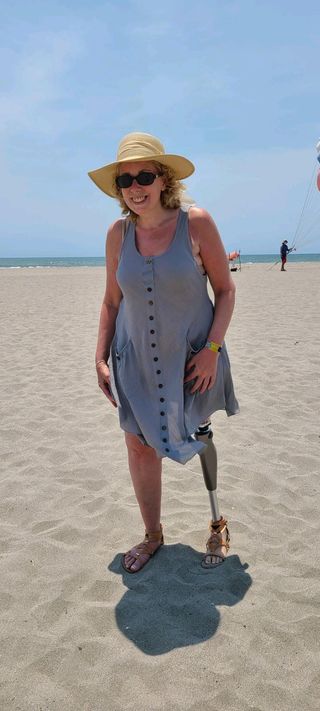
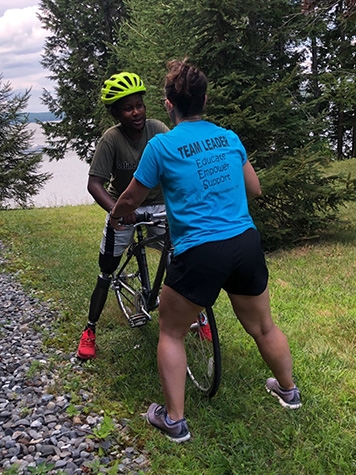
Here are some resources about amputation:
- How An Above Knee Prosthetic Leg Works
- What Amputees Can Expect During the First Six Months Post-Surgery
Here are some patient stories with people who chose amputation:
- Miguel's AMP Story at 18
- Kara's AMP Story at 19
- Alyssa's AMP Story at 23
- Talgot's AMP Story at 28
- Waterslide with AMP
- Rollerblading with AMP
Amputation Pros and Cons
Pros
- The need for additional surgeries is minimal.
- Since the need for surgeries is minimal, the cost and risks of surgery is also less.
- Many amputees report a high level of function and can hike, ride bikes, and run.
- Amputees often use a variety of different legs for different purposes, such as a running blade for running.
- Some prostheses are waterproof and can be worn directly in water for swimming, boating, etc.
- Prosthetic technology in battery life and robotics can contribute to a better quality of life.
Cons
- A prosthesis or assistive device is needed for walking, running, etc.
- A prosthesis can be very expensive, and insurances vary on their coverage.
- A secondary device will be needed when not wearing a prosthesis, such as crutches or a wheelchair.
- It can take a long time (up to two years) for the swelling to go down in your residual limb; this may delay a comfortable fit in a prosthesis.
- Reshaping of the limb may be necessary to get a better fit for the prosthesis.
- Weight gain or loss may require a new socket.
- Common issues include skin breakdown from prosthetic wear and phantom limb pain.
Limb Salvage Surgery
Limb salvage surgery or limb sparing surgery involves removing the tumor and the bone around it and replacing it with metal or bone. You might also hear it described as reconstruction or “saving the leg.” Usually, an artificial knee is also part of a limb salvage surgery, but this is not the same thing as a knee replacement surgery. Limb salvage surgery involves more bone and muscle removal in addition to the artificial knee.

It was really just like we believe we can give you the best odds at survival either way… so, I wanted to try to keep my leg.
Generally, these are some types of limb salvage surgeries:
- Endoprosthesis, a metal implant that replaces the bone, sometimes referred to as a megaprosthesis. This is usually offered for older teens or adults who are mostly done growing.
- Expandable endoprosthesis, a metal implant that can be lengthened with magnets or tiny screws. This is usually offered for older children or young teens to lengthen the endoprosthesis in small amounts, so it grows at a similar rate as the other leg.
- Bone replacement either from a donor bone (allograft) or a bone from the patient’s own body (autograft) plus the artificial knee.
It’s not about what you can’t do, but about what you can. For me it’s not about the limitations I have as a result of limb salvage surgery. I use that as my motivation to move forward, to succeed, to push my own boundaries. It’s the chip on my shoulder. If this never happened, sure, I’d still be able to run and compete. But there’s no way I would have accomplished what I have without this experience. And I live a much more fulfilling life as a result.

One frequently asked question is: If I choose limb salvage first, I can always choose an amputation or rotationplasty later, right? The answer is complicated. Most people have a metal implant with rods that go inside the bone high up in the upper leg or femur and down low in the lower leg or tibia. The amputation would have to be above or below the implant. A rotationplasty might not be possible if the implant would not leave enough of the tibia to be reattached to the femur. An amputation might not be a good option because the femur would be a lot shorter than it would have been if an amputation had been the first surgery. A short femur means less bone to hold the prosthesis and more mobility challenges. For more information about this risk, check out this study: What Are Risk Factors for and Outcomes of Late Amputation.
I’m very fortunate that I have a really good prosthetist. It was hard in the beginning because I couldn’t find someone that could fit me correctly. Me and my prosthetist create my own socket now to fit my bone. Before that, I had struggled a long time because my bone is so short.
Possible Issues with Limb Salvage Surgery
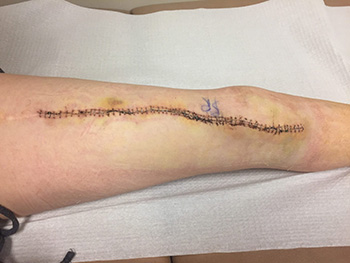
For limb salvage surgery, it is not uncommon to need additional surgeries or even a full revision to replace the implant. All surgeries have a risk for infection. Bacteria can stick to the metal implant, so it is harder to treat completely with antibiotics. Sometimes the entire implant needs to be removed, cleaned, and put back in to clean out all the infection. That can present setbacks for people who must go through rehabilitation again.
When the tumor is removed, surgeons try to get clear or wide surgical margins – enough of the tissue around the tumor for the patient to be cancer free. This can affect the patient’s ability to regain muscle mass in that area. This results in a visible dip in the leg that affects movement and rehabilitation and can also be a source of chronic pain.
I think the key is if they don’t have to take any part of the quad muscle or the tissue around it, you’ve got a much more successful surgery. Again, that’s something I didn’t know. You find out later. Would that have changed our decision? It might have if we had known.
Another common issue is called foot drop when you lose feeling in your foot due to cut nerves during surgery. This makes it hard to walk without tripping. Sometimes patients will use a special brace to help with foot drop. Another issue is complex regional pain syndrome or CRPS. CRPS can be triggered by surgery. The skin becomes shiny and red, and it is very painful.
The sense that I got from the surgeons is that they were presenting limb salvage surgery as the gold standard and they told us that it might fail, generally, but we never knew about the more common problems and challenges limb salvage surgery survivors experience. I understand that drop foot and nerve damage is not uncommon. I also understand that it’s the standard that there are going to be multiple revisions. We never really had those conversations. I don’t think that it would have changed our decision in any way, but it’s certainly something that I would have liked to have known.
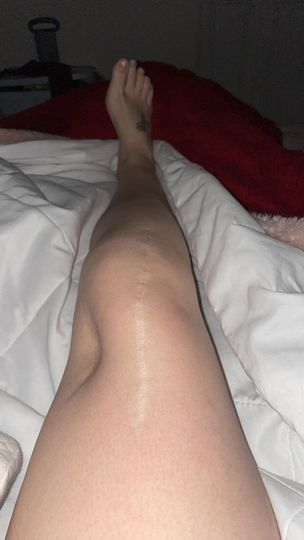
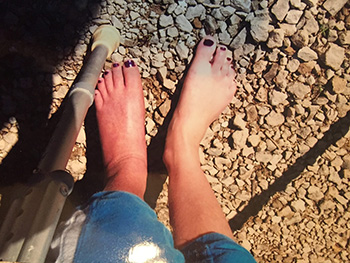
With limb salvage surgery, your best chance for good mobility is your first one. While some patients might go many years without surgery, others have surgery more often to fix broken or loosened parts of the endoprosthesis. If your child has a limb salvage surgery, there may be a limb length discrepancy where one leg is shorter than the other. Scar tissue sometimes develops around the knee, making it difficult to walk or move. Surgeries may be needed to address these issues. The Children's Oncology Group's article Limb Salvage After Bone Cancer has more information about what can happen long-term after LSS.
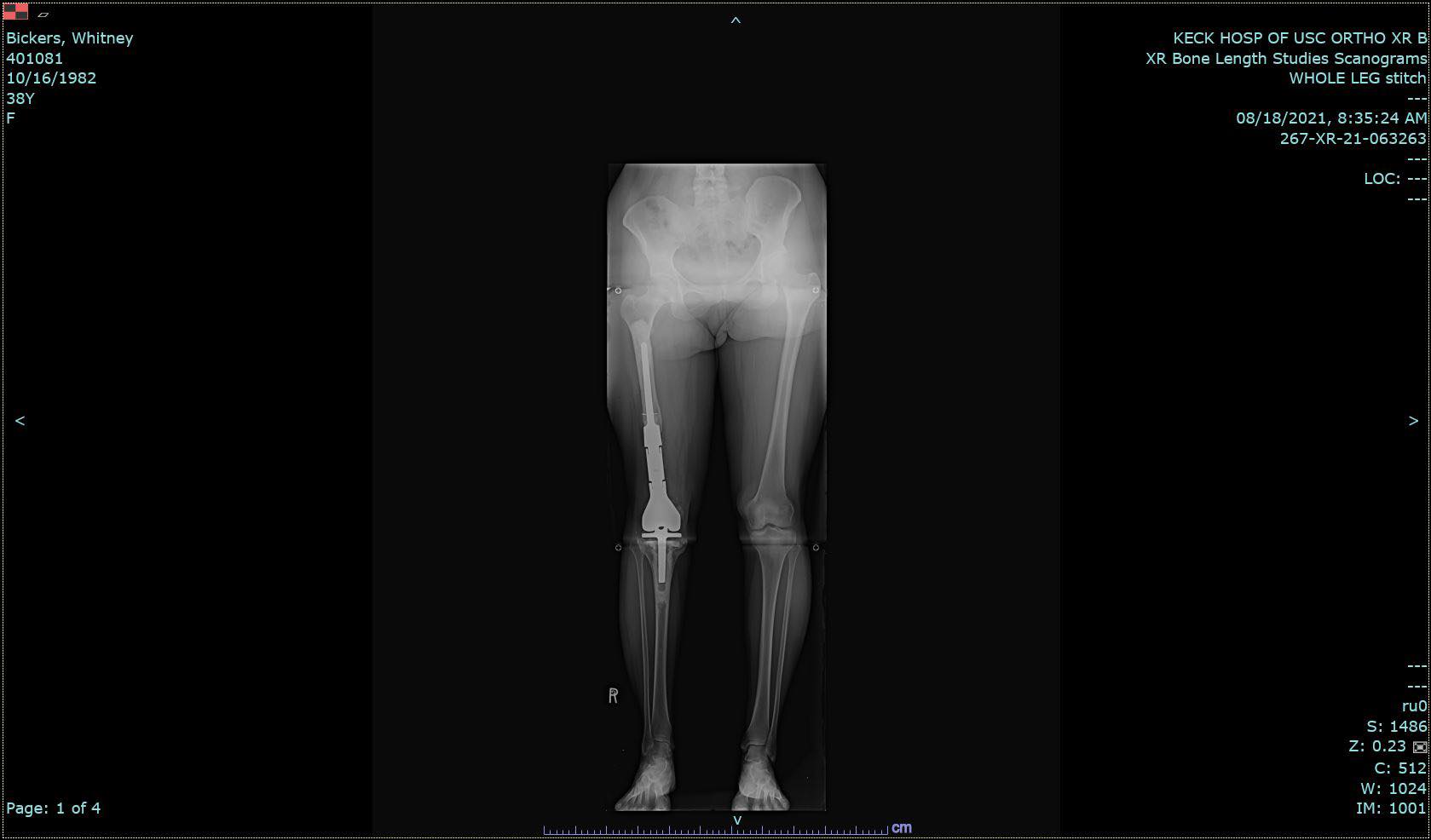
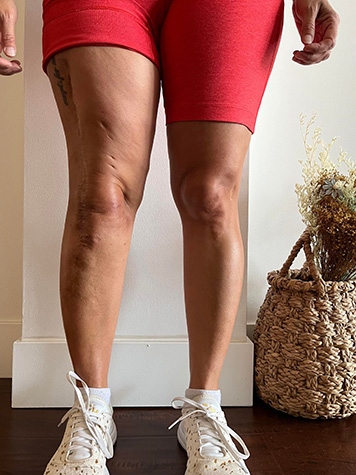
We find that many times, as parents, we had different interpretations of what had been said even though we heard exactly the same conversation. Possibly an audio recording of this appointment would be as beneficial. We were not adequately prepared for graft and hardware failures that resulted in multiple surgeries/recoveries.
The possibility of pain ranges from occasional to daily, and the intensity can vary. Unfortunately, there is no way to predict who will have pain or how that will affect their lives.
It still aches a lot, especially in the cold weather. It gets a lot more stiff, pops and cracks sometimes, which is a little unnerving. I keep freaking out about something breaking. It’s just kind of a dull ache, like the restless leg syndrome kind of thing, just constantly. You just have to learn to tune it out eventually. I use the cane for long walks, mostly for balance—the leg gives out sometimes because there’s no muscle holding it all together. So, it’s not like a regular leg where it just kind of like locks and you’re fine. I have to constantly just be holding it if that makes sense. So, when I’m walking, just in case it gives out, I need something to put all my weight on. Other than that, not too many horrible issues with it.

Here are some resources about limb salvage surgery:
- LSS explained and animated video
- Orthopedic patient education animated video for LSS
- Examples of metal implants: Zimmer Biomet and Stryker
Here are some personal stories of people who chose limb salvage surgery:
Limb Salvage Surgery Pros and Cons
Pros
- The leg appears normal.
- The leg can be lengthened for children.
- Some people do very well with LSS and can be very active though surgeons may advise no high impact activities.
- You keep your leg so there is no need for a prosthesis.
Cons
- There will be a long scar and the leg may be smaller in diameter due to the removal of muscle or surrounding tissue around the tumor.
- There are limits to how much the leg can be lengthened. For this reason, LSS may not be considered a good option for young children.
- Future surgeries are expected, some minor, some major. Sometimes the entire implant will need to be replaced. Surgeries can be expensive.
- You may need to use a cane or crutches at times.
- It can be difficult for some patients to regain their range of motion after a lengthening.
- You will not know how many surgeries you will need and those are often unexpected.
- Common complications include foot drop, where the patient loses feeling and control of their foot. This can cause tripping and walking problems.
- Pain can vary from short term to chronic daily pain. It is uncertain who will experience pain or how long it will last.
- Removal of the quadriceps muscle in front of the thigh can affect the ability to go up and down stairs, walk distances, bike, etc. Some patients have a brace made to help control balance.
- Amputations after limb salvage surgery may result in a shorter femur above the implant. The residual limb might not be long enough to get a good prosthetic fit.
Rotationplasty
Rotationplasty surgery removes the tumor around the knee along with the surrounding tissue and bone. The surgeon then rotates the lower leg 180 degrees and reattaches it to the femur.
The resulting appearance is a backwards foot on a much shorter leg. The ankle then serves as a knee joint, and the patient has full sensation of their foot. This allows a patient who would otherwise require an above knee amputation to have function closer to what a below knee amputee would have. As a result, it takes less energy to be active and the prosthesis only has to make up for one joint, the ankle.
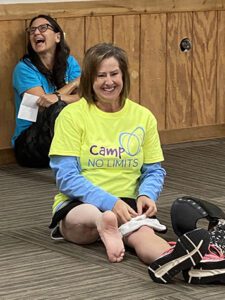
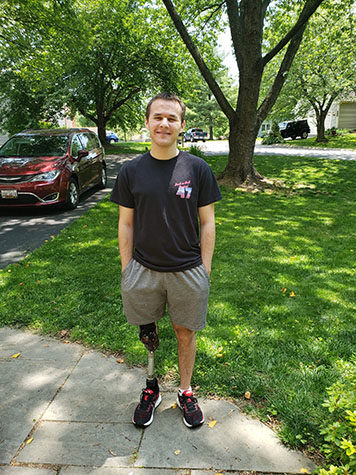
I know that it's very hard to look at pictures of people with rotationplasty, but that is definitely the best way to do things. Not even just rotationplasty but if amputation is one of your options, seeing people with amputation, single or double, above-the-knee or below-the-knee, whichever. Prior to sled hockey and adaptive sports, I’d never really seen people with prosthetics and without legs. I had no exposure to that at all. You kind of think that’s weird, but that’s why so many people, I catch them just staring at my leg. To me, it’s kind of a normal thing. My mind is normalized. I think to make a decision for amputation, you need to have some sort of increased exposure to it, to not just rotationplasty but the idea of amputation, to normalize your mind. It’s not something that is shown often.
The appearance of a backwards foot can be concerning for some patients and parents at first.
In my head I thought no self-respecting parent would ever let him do that. That’s just too off the wall.
Before rotationplasty: The surgeon described it to us. It sounded awful, so we immediately said no. We looked it up later and it was shocking. After rotationplasty: Everyone acts like this is such a big deal, but my leg feels great!
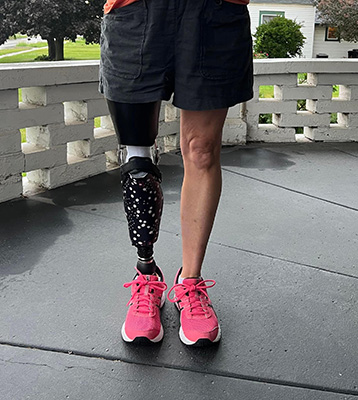
Possible Issues with Rotationplasty
People with rotationplasty sometimes have problems with the bones connecting or fusing together after surgery. Chemotherapy can slow down this progress even more. This means being on crutches longer, along with surgery to help with bone fusion or even a bone graft and will delay wearing a prosthesis by many weeks or months.
Loss of blood flow immediately after surgery can cause complications later, such as tissue or skin healing problems. Scar tissue can also build up and cause a stiff or “frozen ankle.” Stretching to increase range of motion helps avoid some of these complications. Nerve damage can also occur as a result of surgery, resulting in pain and/or numbness.
Sometimes people have trouble with pain associated with pressure points where the foot rubs against the prosthesis. Prosthetists often have creative ways to manage these complications from using parts of shoes in the foot shell to adjustments so specific muscles will be used better for improvement.
Extreme complications can sometimes lead to amputation. "Complications and risk factors for failure of rotationplasty: review of 24 patients" is a study that looked at complications and risks from rotationplasty.
My son initially had a rotationplasty but due to an infection, he had to be fully amputated just 7 days after the surgery. He was able to ride a bike 4 months after he got his prosthetic and 8 months after his amputation. My son is now 14 and is living life as if cancer never happened.
Here are RP resources:
- Rotationplasty Animated Surgery from MD Anderson
- Rotationplasty Explained from Boston Children's Hospital
- A 2020 study comparing long-term function between RP & LSS
- One Surgeon's Perspective on the Pros of RP
- Playing basketball with rotationplasty
Here are RP patient stories:
- Liam's RP Story at 7
- Jani's RP Story at 9 - Advocate for Body Empowerment
- Jude's RP Story at 11
- Delaney's RP Story at 11 - Dancer
- Sam's RP Story at 13 - Paralympic High Jumper
- Parker's RP Story at 20
Rotationplasty Pros and Cons
Pros
- The need for additional surgeries is minimal.
- Since the need for surgeries is minimal, the cost and risks of surgery is also less.
- Amputees often use a variety of different legs for different purposes, such as a running blade for running.
- It usually does not take very long to get fitted and walking with a prosthesis.
- Many amputees report a high level of function and can play high-impact sports.
- Some prostheses are waterproof and can be worn directly in water for swimming, boating, etc.
- Only one joint is removed (the knee) so only one joint is needed for the prosthesis. This requires less energy to move around.
- People with rotationplasty often do not have phantom limb pain. This is because the nerves are not cut.
- Rotationplasty is useful for young children who are still growing as their leg and foot will continue growing too.
Cons
- A prosthesis is needed for walking, running, etc.
- A prosthesis can be expensive, and insurances vary on their coverage.
- Finding a nearby prosthetist who can make a prosthesis for RP can be challenging in some areas.
- The appearance of a backwards foot on a shortened leg may be a challenge.
- A different prosthesis is often used for different activities.
- The prosthesis will need to be adjusted as a child grows to match their other leg.
- It can be challenging to find a prosthetist with experience in designing prosthetics for rotationplasty.
- There may be skin issues as a result of wearing a prosthesis.
- Reshaping of the residual limb as a child grows may be necessary to get a better fit for the prosthesis.
You Might Hear About...
Distraction Osteogenesis
Distraction osteogenesis uses the patient’s own bone to create new bone by slowly stretching a bone over time. It works best if the tumor is in the tibia (lower leg) or femur (upper leg) rather than in the knee joint, the most common location for osteosarcoma. It is a complicated technique that can take years and there are not many surgeons who can do it.
The pros include keeping your own leg and no activity limitations when it is done. The cons include the length of time it takes, loss of motion around joints and strength due to scarring while the bone is being stretched and, as with all the options, the risk of infection. Sometimes an external fixator or cage on the outside of the leg is used that limits movement and makes hygiene a challenge. As with limb salvage surgery, later options for other surgeries can be much harder.
Distraction osteogenesis is not a good option for tumors around the knee joint so it will not be discussed further in this decision aid but here are some resources where you can get more information:
- Ian's Distraction Osteogenesis Story - tumor in the middle of tibia
- Memorial Sloan Kettering Distraction Osteogenesis
- Distraction Osteogenesis Webinar
Osseointegration
Osseointegration is for people who have had an amputation for some time, and they have issues with the socket for the artificial leg (prosthesis). They have a metal implant inserted into their bone with a metal rod that sticks out. A prosthesis then fits over the rod, rather than over the skin. Infection is always a risk for people with osseointegration, but some people find that they have better mobility without the socket on their limb.
Osseointegration is not a good option for tumors around the knee joint as a first surgery, but it could become an option over time if needed. Here are some resources about osseointegration:

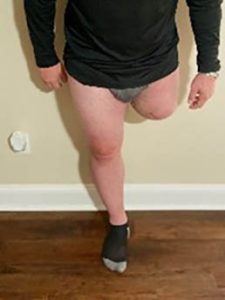
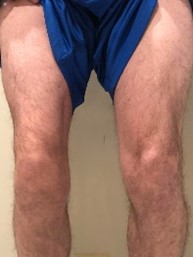
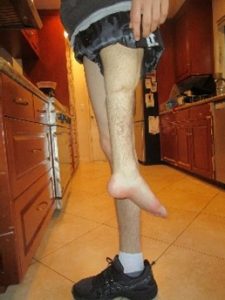
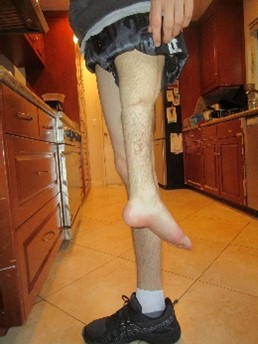

Social Support
Social support and hearing the stories of others can be helpful. If you want to talk to other parents or adults who made the decision for surgery, they can be found in the groups listed below.
The highlighted text is a link that will take you directly to that webpage. Hover over it, or click on it, and you will go directly to the group. Public Facebook groups are open and visible to anyone who opens the Facebook page. Private Facebook groups require a screening process with questions about joining before the moderator approves new members. Many members find others who live in areas near them so they can meet in person.
Parent
Social Support: Facebook
Ewings Sarcoma Awareness (public) was created in 2006. It is dedicated to the exchange of information regarding Ewing Sarcoma. Everyone in this public group is reviewed by administrators before they can post or comment for the first time.
Osteosarcoma and Ewing's Sarcoma Support Group (public) was created in 2010. The purpose of this support group is to provide a safe place where individual experiences and knowledge are shared. Expert patients include survivors, parents, and family members who are here to answer questions. This is the largest support group for osteosarcoma and Ewing sarcoma.
Bad to the Bone: Decision Support for Bone Cancer in the Lower Limb (private) was created in 2023. The purpose of this group is to provide a space for people to discuss options for orthopedic surgery over their lifespan. Newly diagnosed patients and families are welcome here as well people making the decision for a different surgery later in life. The Osteosarcoma Patient Decision Aid for Surgery in the Lower Limb can be found here.
Bone Cancer Support...for lives touched by Osteosarcoma & Ewing Sarcoma (private) was created in 2019. The purpose of this group is to offer a safe environment with support from people who listen, respect, understand and generously share their knowledge and experience. They offer support to the newly diagnosed, the fighters, the survivors, and those who have lost their loved ones to primary bone cancer.
Osteosarcoma Information (private) was created in 2019. The purpose of this group is to provide scientific and medical information to families and patients regarding human osteosarcoma treatments, clinical trials, and research in an accessible way. Information provided in this group is not meant to substitute for medical advice, nor should it be understood as prescribing a specific treatment. This group is for information and support when talking with your doctors.
Rotationplasty (private) was created in 2013. The purpose of this group is for members to post resources and ask questions about rotationplasty and prosthetics. Members include people making a surgical decision as well as people with rotationplasty and their families. Healthcare providers such as prosthetists and orthopedic surgeons are also welcome.
Above Knee Amputees (private) was created in 2016. Most people have AKAs due to other reasons but there are members here who had bone cancer. This is a useful resource for learning about the many different kinds of prosthetics.
Social Support: Organizations
Amputee Coalition has a Peer Support Program that will match patients and caregivers. This is for support only, and they do not offer advice. Persons requesting peer support must be scheduled for an amputation or rotationplasty to be matched.
MIB Ambassador Agents: Connects osteosarcoma patients and families to osteosarcoma survivors and their families to provide support to those in treatment. This program is specific for kids and young adults diagnosed with osteosarcoma.